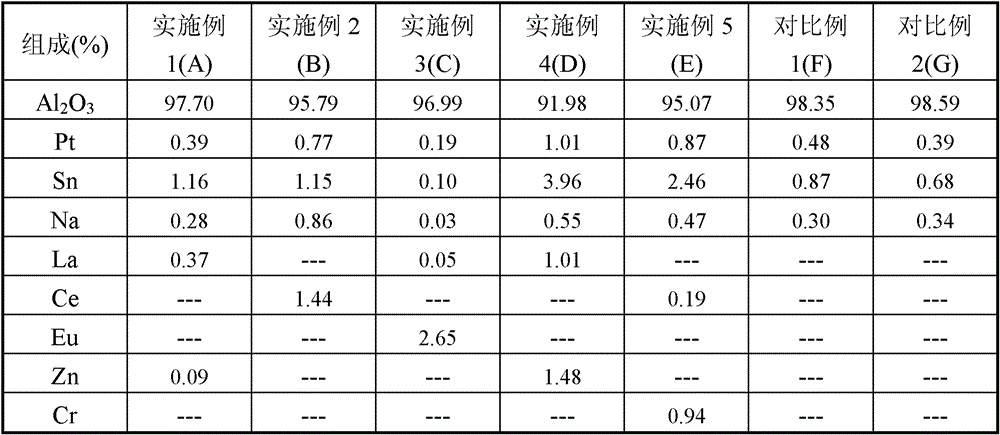Catalyst for low-carbon alkane dehydrogenation and preparation method thereof
A low-carbon alkane and catalyst technology, which is applied to the catalyst and preparation field of a low-carbon alkane dehydrogenation catalyst, can solve the problems of poor catalyst stability, easy deactivation of catalyst coke deposition, slow deactivation rate of catalyst coke deposition, and the like, and achieves high performance. stable effect
- Summary
- Abstract
- Description
- Claims
- Application Information
AI Technical Summary
Problems solved by technology
Method used
Image
Examples
Embodiment 1
[0025] In 300.2g of pseudo-boehmite raw powder main material, add 9.0g of turnip powder and mix evenly, then add 130ml of mixed solution containing catalyst active components, including SnCl 4 ·5H 2 O, 7.4g; NaNO 3 , 2.2g; La(NO 3 ) 3 ·6H 2 O, 2.5g; Zn(NO 3 ) 2 ·6H 2 O, 0.91g, extruded after kneading fully, placed at room temperature for 12 hours, then kept at 90°C for 3 hours, then dried at 120°C for 10 hours, pelletized and treated at 750°C to obtain a tin-containing composite carrier.
[0026] The composite alumina support obtained adopts the impregnation technique to support the platinum component, that is, the chloroplatinic acid (H 2 PtCl 6 6H 2 O, 2.23g) in aqueous solution for 24 hours (metal platinum loading 0.4%, Pt:Sn=1:2), then dried at 60°C, calcined at 530°C for 3 hours in air flow, and then treated with water vapor at 530°C After 4 hours, dry air was finally passed through at 530°C for 1 hour to obtain a catalyst sample, which was denoted as A. The co...
Embodiment 2
[0029] Catalyst is prepared by the method of embodiment 1, and difference is with pseudo-boehmite former powder 285.7g; SnCl 4 ·5H 2 O, 2.4g; NaNO 3 , 1.8g; Ce(NO 3 ) 3 ·6H 2 O, 3.0g; H 2 PtCl 6 6H 2 O, 1.6g; without Zn (NO 3 ) 2 ·6H 2 O. Gained catalyst composition is shown in Table 1, is recorded as B, and reaction result is shown in Table 2, and reaction condition is the same as embodiment 1.
Embodiment 3
[0031] Catalyst is prepared by the method of embodiment 1, and difference is to use pseudo-boehmite former powder 345.7g; SnCl 4 ·5H 2 O, 0.7g; NaNO 3 , 0.3g; La(NO 3 ) 3 ·6H 2 O, 0.4g; H 2 PtCl 6 6H 2 O, 1.3g; Eu 2 o 3 , 15.28g; without Zn (NO 3 ) 2 ·6H 2 O. The obtained catalyst composition is shown in Table 1, and is recorded as C, and the reaction results are shown in Table 2, and the reaction conditions are the same as in Example 1.
PUM
 Login to View More
Login to View More Abstract
Description
Claims
Application Information
 Login to View More
Login to View More - R&D
- Intellectual Property
- Life Sciences
- Materials
- Tech Scout
- Unparalleled Data Quality
- Higher Quality Content
- 60% Fewer Hallucinations
Browse by: Latest US Patents, China's latest patents, Technical Efficacy Thesaurus, Application Domain, Technology Topic, Popular Technical Reports.
© 2025 PatSnap. All rights reserved.Legal|Privacy policy|Modern Slavery Act Transparency Statement|Sitemap|About US| Contact US: help@patsnap.com



